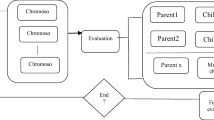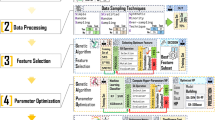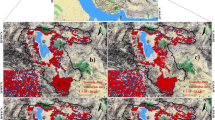Abstract
An application of classifier fusion technique is presented to improve the performance of automated reservoir facies identification system. The algorithm presented in this study uses three well-known classifiers, namely Bayesian, k-nearest neighbor (kNN), and support vector machine (SVM) to automatically identify four defined facies of Asmari Formation from log-derived amplitude versus offset (AVO) attributes. Fuzzy Sugeno integral (FSI) method is then employed to combine the outputs of three investigated classifiers and increase the consistency of reservoir facies identification process. The experimental results obtained from applying the presented algorithm on data related to three wells drilled in Asmari Formation provide evidence of the effectiveness of the proposed algorithm regarding true positive (TP), false positive (FP), and classification accuracy criteria.







Similar content being viewed by others
References
Abdollahi fard IA, Braathen A, Mokhtari Mand Alavi SA (2006) Interaction of the Zagros Fold-Thrust Belt and the Arabian-type, deep-seated folds in the Abadan Plain and the Dezful Embayment, SW Iran. Pet Geosci 4:347–362
Alavi M (2004) Regional stratigraphy of the Zagros fold-thrust belt of Iran and its proforeland evolution. Am J Sci 304:1–20
Alsharhan AS, Nairn AEM (1997) Sedimentary basins and petroleum geology of the middle east. Elsevier, Amsterdam, New York
Chamberlain AK (1984) Surface gamma-ray logs: a correlation tool for frontier areas. Am Assoc Pet Geol Bull 68:1040–1043
Chopra S, Alexeev V, Xu Y (2003) Successful AVO and cross-plotting. CSEG Rec 28(09):1–12
Connolly P (1999) Elastic impedance. Lead Edge 18:438–452
Crampin T (2007) Well log facies classification for improved regional exploration. Explor Geophys 39(2):115–123
Duda RO, Hart PE, Stork DG (2002) Pattern classification, 2nd edn. Wiley, New York
Dumay J, Fournier F (1988) Multivariate statistical analyses applied to seismic facies recognition. Geophysics 53:1151–1159
Dypvik H (1993) Natural gamma activity—a possible aid in sedimentological fieldwork. Nor Geol Tidsskr 73:58–62
Goodway W (2001) AVO and Lam’e constants for rock parameterization and fluid detection. CSEG Rec 26:39–60
Han M, Zhao G, Reynolds A (2010) Application of em algorithms for seismic facices classification. J Comput Geosci 15:421–429. doi:10.1007/s10596-010-9212-4
Jordan DW, Slatt RM, D’Agostino A, Gillespie RH (1991) Outcrop gamma ray logging: truck-mounted and hand-held scintillometer methods are useful for exploration, development, and training purposes. Paper SPE 22747, presented at the society of petroleum engineers, 66th annual technical conference and exhibition, Dallas, pp 841–852
Kumar B, Kishore M (2006) Electrofacies classification—a critical approach. In: Sixth international conference and exposition on petroleum geophysics
Larsen AL, Ulvmoen M, Omre H, Buland A (2006) Bayesian lithology/fluid prediction and simulation on the basis of a Markov-chain prior model. J Geophys 71:R69–R78
Lee SH, Khargoria A, Datta-Gupta A (2002) Electrofacies characterization and permeability predictions in complex reservoirs. SPE Reserv Eval Eng 5:237–248
Lipo W (2005) Support vector machines: theory and applications. Springer, Berlin
Lu S, McMechan GA (2004) Elastic impedance inversion of multichannel seismic data from unconsolidated sediments containing gas hydrate and free gas. Geophysics 69(1):164–179
Mathieu PG, Rice GW (1969) Multivariate analysis used in the detection of stratigraphic anomalies from seismic data. Geophysics 34:507–515
Mohri M, Rostamizadeh A, Talwalkar A (2012) Foundations of machine learning. The MIT Press, Cambridge
Mollajan A, Mehrgini B, Memarian H (2013) Zonal classification by pattern recognition methods: an example from Asmari formation (Manouri oil field, south of Iran). J Energy Explor Exploit 31(3):367–380
Mollajan A, Mehrgini B, Memarian H (2015) A fusion approach to identify reservoir facies based on rock physics modeling. Arab J Geosci. doi:10.1007/s12517-015-1849-9
Moss B (1997) The partitioning of petrophysical data: a review. In: Lovell LL, Harvey RL (eds) Developments in petrophysics, vol 122. Geological Society Special Publication, London, pp 181–252
Motiei H (1993) Stratigraphy of Zagros in Treatise of geology of Iran, Iran Geological. Survey 1:281–289 (In Persian)
Myers KJ, Bristow CS (1989) Detailed sedimentology and gamma-ray log characteristics of a Namurian deltaic succeSSiOn. II. Gamma-ray logging. In: Whateley MKG, Pickering KT (eds) Deltar sites and traps for fossil fuels, vol 41. Geological society, London, pp 81–88
North CP, Boering M (1999) Spectral gamma-ray logging for facies discrimination in mixed fluvial-eolian successions: a cautionary tale. Bull Am Assoc Pet Geol 83:155–169
Paparozzi E, Grana D, Mancini S, Tarchiani C (2011) Seismic driven probabilistic classification of reservoir facies and static reservoir modeling. In: 73rd EAGE conference and exhibition incorporating SPE EUROPEC Vienna, Austria
Quakenbush M, Shang B, Tuttle C (2006) Poisson impedance. Lead Edge 25(2):128–138
Rao YH, Biswal AK (2004) Comparative study of AVO attributes for reservoir facies discrimination and porosity prediction. In: Fifth conference and exposition on petroleum geophysics, Hyderabad-2004, India, pp 498–502
Reading HG (1996) Sedimentary environments and facies. Blackwell Scientific Publications, Oxford
Shakhnarovish G, Darrell T, Indyk P (2005) Nearest-neighbor methods in learning and vision: theory and practice. MIT Press, Boston
Sherkati S, Letouzey J (2004) Variation of structural style and basin evolution in the central Zagros (Izeh zone and Dezful Embayment), Iran. Mar Pet Geol 21:535–554
Theodoridis S, Koutroumbos K (2002) Pattern classification, 2nd edn. Elsevier, San Diego
Woods K, Kegelmeyer WP, Bowyer K (1997) Combination of multiple classifiers using local accuracy estimates. IEEE Trans Pattern Anal Mach Intell 19(4):405–410
Xu Y, Chopra S (2008) Deterministic mapping of reservoir heterogeneity in Athabasca oil sands using surface seismic data. Lead Edge 27(9):1186–1191
Xu C, Torres-Verdin C (2014) Petrophysical rock classification in the Cotton Valley tight-gas sandstone reservoir with a clustering pore-system orthogonality matrix. Interpretation 2(1):13–23
Acknowledgements
The authors would like to acknowledge the financial support of University of Tehran for this research under Grant Number (22708/1/02).
Author information
Authors and Affiliations
Corresponding author
Rights and permissions
About this article
Cite this article
Mollajan, A., Memarian, H. & Nabi-Bidhendi, M. Fuzzy classifier fusion: an application to reservoir facies identification. Neural Comput & Applic 30, 825–834 (2018). https://doi.org/10.1007/s00521-016-2690-0
Received:
Accepted:
Published:
Issue Date:
DOI: https://doi.org/10.1007/s00521-016-2690-0




